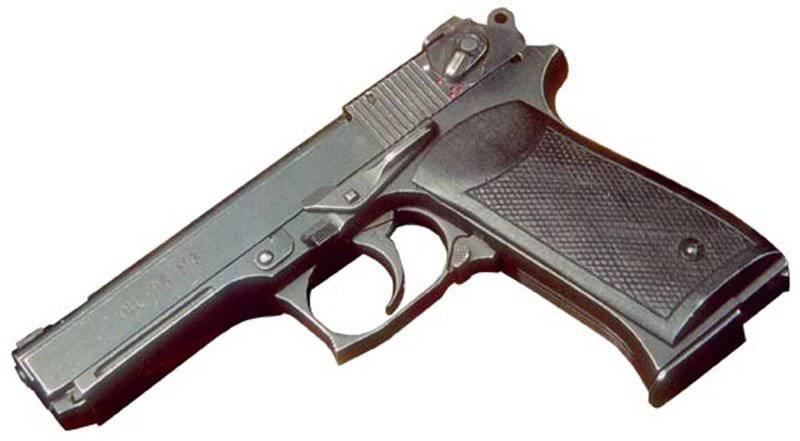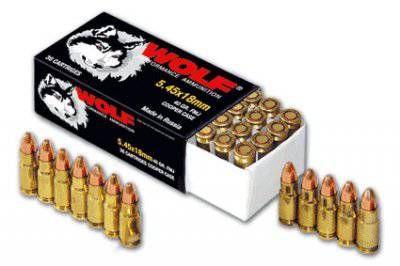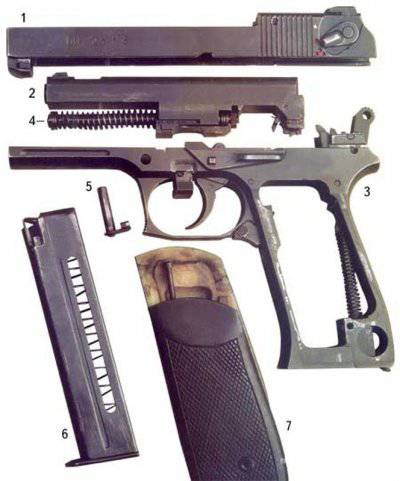Small-bore "Dart"

At the end of the 60's, the intelligence services expressed a desire to get a small-sized pistol, allowing the operative to wear it covertly and not unmasked. Initially, however, this gun was conceived as a personal weapon commanders of "organs", but then its characteristics attracted the attention and operational staff. Therefore, it was decided to expand the scope of the use of future weapons. As for the dimensions, some sources say: in the technical specifications for the pistol, the thickness of the future weapon was required no more than the matchbox: 17-18 mm. Very attractive, although then the small size of the gun will cause controversy.
Only two pistols were presented to the competition: BV-025 designer V. Babkin with TsNIITochmash and PSM designers of the Tula TsKIBSOO T. Lashneva, A. Simarina and L. Kulikova. Both pistols were made chambered for MPTs created at TsNIITochmash.
 At the patron is to stay separately. The fact is that the 5,45x18 mm MMP ammunition, also known as 7H7, turned out to be the most controversial and most crucial moment in the biographies of all the pistols that were developed for its use. The choice of such a small caliber was dictated by the requirements of the technical project: to enter the mechanism for a larger caliber in millimeters 17-18, at least, it is very difficult.
At the patron is to stay separately. The fact is that the 5,45x18 mm MMP ammunition, also known as 7H7, turned out to be the most controversial and most crucial moment in the biographies of all the pistols that were developed for its use. The choice of such a small caliber was dictated by the requirements of the technical project: to enter the mechanism for a larger caliber in millimeters 17-18, at least, it is very difficult.The MOC was created by Klimov engineers under the leadership of A. Denisova. In fact, it was made from a new 5,45-mm bullet and cartridge case from the PM cartridge. Since the cartridge was made for “police” weapons, it was decided not to “inflate” the characteristics. 2,5-gram bullet charge in 0,15 grams accelerates just up to 310-320 meters per second. Let's face it a little. But for shooting at targets at a distance of 20-30 meters it was considered sufficient. In addition, due to the special bullet with a pointed "nose" (on it, it should be noted, there is a small flat platform to reduce the likelihood of a ricochet) at the indicated distances, the cartridge is able to pierce soft Kevlar body armor 1-2 protection class. Interestingly, the bullet has a composite core (steel nose, back - lead) and does not break through the fabric, but pushes its fibers. However, the MPTs have a drawback - due to the light and slow bullet, its stopping effect is less than that of other pistol cartridges, for example, the PM. But more about that later.
In the competition for a small-sized pistol, the Tula PSM won, and in 1972, he went into the series. The gun immediately liked the users in terms of ease of wearing. But with the use of some problems. As stated above, the stopping effect of the bullet is below the piercer. There is information that because of this there were characteristic cases: an employee of the authorities used the PSM against the criminal, he “caught” the bullet, but continued to resist and try to escape. And only during the chase, the villain suddenly ceased resistance due to blood loss. Whether the ambulance managed to get to the place of detention and ensure the presence of the criminal during the investigation and trial is unknown. The good old Makarov pistol in this regard was much more convenient, although it had large dimensions. Therefore, by the end of 80-x PSM was used only as personal weapons comrades with big stars, and then as a premium. Operatives, in turn, by the time of the PSM refused.
At the beginning of the last decade of the last century, the Ministry of Internal Affairs again thought about the new gun. Only this time he was supposed to be a substitute for Kalashnikov assault rifles, reliable and convenient, but dangerous for the civilian population in urban environments. The order for the new pistol was received by the Tula TsKIBSOO, and the group of designers was headed by I. Stechkin, the creator of the famous APS. The topic was called OTs-23 or SBK (Stechkin, Balzer, Zinchenko), and later the name “Dart”. The small-caliber cartridge of the MPT was chosen as the ammunition for the Dart. The OZ-23 was made as a “pocket submachine gun” for law enforcement agencies, so it was decided to use a cartridge optimized for urban conditions and distances. Perhaps someone will ask if the MOC has already tried to put it into practice and are disappointed, why make another gun under it? Stechkin, Balzer and Zinchenko decided to compensate for the stopping quality with a quick-fire quantity: once the gun is automatic, then let it fire three shots with a cut-off. And such queues without recharging can be done as many as eight - the standard Dart shop holds the 24 cartridge. The rate of firing within the queue is about 1800 shots. Since such a pace can not affect the accuracy and accuracy, which is important specifically for this gun, a muzzle brake-compensator was added. It looks like the holes on the upper side of the barrel and on the casing. Due to this, part of the powder gases ejected upwards, reduces the jump of the gun.
The second innovation to improve accuracy and "laying" of all three bullets nearby - the original mount barrel. After the shot, the bolt under the influence of recoil goes back, throws out the cartridge case and catches the barrel. Already together, the barrel and bolt are shifted another few millimeters. To return to the original position, the bolt and barrel have their own springs. By shifting back more mass than in the case without a moving barrel, the toss of the pistol is further reduced. Together with the muzzle brake-compensator, this helped to significantly improve the accuracy of the fight. In domestic weapons such a system was used for the first time.
The trigger-trigger mechanism OTs-23 of double action has an open trigger and allows to shoot both from a samovzvod, and from a preliminary cocking. The safe handling of the gun is ensured by a non-automatic safety lock. It is located on the back of the casing of the shutter and at the same time serves as a translator of fire. Fuse-translator has three positions: blocking, single fire and in bursts of three. Taking care of left-handed shooters, the designers brought out the fuse flags on both sides of the gun.
The “Dart” sight is open, and there are grooves on the frame under the barrel for mounting a different “body kit”. The butt of the pistol is not allowed - it was already specified in the technical specifications.
The characteristics of the OTs-23 are not inferior, and sometimes even surpass the PSM, however, the “curse” of the MPT cartridge also hung over it. Slightly longer barrel “Dart” and automatic fire with a great pace could not compensate for the small stopping effect, and the Ministry of Internal Affairs needed just a “stopping” gun. So go to the big series "Dart" could not.
In the middle of 90, the Ministry of Internal Affairs again turned to TsKIBSOO for a gun. This time they wanted to get a gun, similar to the OC-23, but calculated for a different cartridge - PM or PMM. The OZ-33, or Pernach, was indeed developed on the basis of the Dart, although some changes were made. For example, the cut-off of three shots was removed, the rate of fire was reduced to 850 shots per minute, a detachable metal butt was added, etc. “Pernach”, possessing a more powerful and effective patron, turned out to be not much luckier than its predecessor. The OZ-33 is also produced in small batches, but at the same time the reviews about it are much better than about the “Dart”. However, this is another story and another gun.

Information